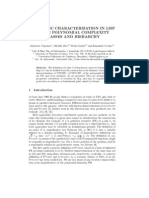Characteristics The Frog
Characteristics The Frog
Uploaded by
HelenPetersenCopyright:
Available Formats
Characteristics The Frog
Characteristics The Frog
Uploaded by
HelenPetersenOriginal Title
Copyright
Available Formats
Share this document
Did you find this document useful?
Is this content inappropriate?
Copyright:
Available Formats
Characteristics The Frog
Characteristics The Frog
Uploaded by
HelenPetersenCopyright:
Available Formats
CHARACTERISTICS Frogs have very good eyesight.
They bulge out the sides of their heads in order for the frog to see in nearly all directions. Frogs also have amazing sense of hearing. You can often tell the difference between a male and female frog by the size of their eardrum, which can be seen behind their eyes. If the eardrum is smaller than the eye, the frog is a female. On males their eardrum is the same size as the eye. Frogs have very powerful back legs and webbed feet that help them jump great distances, as well as, swim. Frogs even use their legs to dig, or burrow, underground for hibernating. Certain frogs can jump up to 20 times their own body length in a single leap. Every different species of frog has his or her own look. They come in many colors, patterns and sizes. Frogs have many predators. Animal predators include birds, fish and reptiles. Most rainforest frogs have pads of sticky hairs on their fingers and toes, as well as, loose sticky skin on their bellies, that make them great climbers to escape their predators. Many of these frogs live in high trees for safety. Other frogs are very good at camouflaging themselves so that they blend in with their environment, making it harder for their enemies to find them. A frog can change the colour of its skin depending on its surroundings. Humans have become a major danger for amphibians of all types. Water pollution is causing many deformities in frogs as well as poisoning them, and loss of habitat through the building of roads and houses. In some countries, frogs legs are considered a delicacy, which means that people love to eat them! Eew! Breathing is a gas exchange, taking in oxygen from the surroundings and letting out carbon dioxide. All frogs start life as aquatic tadpoles, breathing underwater through internal gills and their skin. Then later most develop into land animals with lungs for breathing air. But in all stages breathing is controlled by pulsing the throat. Most frogs lose their gills when they metaorphise. Frogs breath with their mouths closed. Their throat movements pull air through the nostrils to the lungs. Then breathe out with body contractions. The activity and temperature of an animal determine how important breathing is. Anurans have much more complex lungs then other amphibians, such as salamanders, because they're more active and have higher body temperature. Lungs can also help in water. Filling the lungs with air gives frog better buoyancy, making it float more easily. Frogs can also breath through their skin, with tiny blood vessels, capillaries, under the outer skin layers. The African 'Hairy' frog, Trichobatrachus robustus, has small lungs and during breeding seasons the males get hair like projections on their back legs. This is because of the high oxygen needs at this time.
THE DATING GAME/REPRODUCTION when male frogs are ready to mate they will call out to the female frogs. Each different species of frog has their own special sound and that is the sound that the same species of female frog will answer to. Some frogs are so loud they can be heard a mile away! After they meet, they find a suitable spot to mate and lay their eggs. The male frog will hug the female from behind and as she lays eggs, usually in the water, the male will fertilize them. After that the eggs are on their own, to survive and become tadpoles. There are a few species of frogs that will look after their babies, but not many. When Frogs mate, the male frog tends to clasp the female underneath in an embrace called am plexus. He literally climbs on her back, reaches his arms around her "waist", either just in front of the hind legs, just behind the front legs, or even around the head. Am plexus can last several days! Usually, it occurs in the water, though some species, like the buffos on the right mate on land or even in trees! While in some cases, complicated courting behavior occurs before mating, many species of frogs are known for attempting to mate with anything that moves which isn't small enough to eat! Spawn (egg-mass) While in the am plexus position, the male frog fertilizes the eggs as they get are laid. Frogs tend to lay eggs single eggs in masses, whereas toads usually lay eggs in long chains. Some frogs leave after this point, but others stick around to watch over the little ones. Some have very unusual ways of caring for their young. You'll learn about some of those later in this tour! Egg Frogs and Toads tend to lay many eggs because there are many hazards between fertilization and full grown frogness! Those eggs that die tend to turn white or opaque. The lucky ones that actually manage to hatch still start out on a journey of many perils. Life starts right as the central yolk splits in two. It then divides into four, then eight, etc. - until it looks a bit like a raspberry inside a jello cup. Soon, the embryo starts to look more and more like a tadpole, getting longer and moving about in its egg. Usually, about 6-21 days (average!) after being fertilized, the egg will hatch. Most eggs are found in calm or static waters, to prevent getting too rumbled about in infancy! Some frogs, like the Coast foam-nest tree frog, actually mate in tree branches overlooking static bonds and streams. Their egg masses form large cocoonlike foamy masses. The foam sometimes cakes dry in the sun, protecting the inside moisture. When the rain comes along, after development of 7 to 9 days, the foam drips down, dropping tiny tadpoles into the river or pond below. Tadpole Shortly after hatching, the tadpole still feeds on the remaining yolk, which is actually in its gut! The tadpole at this point consists of poorly developed gills, a mouth, and a tail. It's really fragile at this point. They usually will stick themselves to floating weeds or grasses in the water using little sticky organs between its' mouth and belly area. Then, 7 to 10 days after the tadpole has hatched, it will begin to swim around and feed on algae. After about 4 weeks, the gills start getting grown over by skin, until they eventually disappear. The tadpoles get teeny tiny teeth which help them grate food turning it into soupy oxygenated particles. They have long coiled guts
that help them digest as much nutrients from their meager diets as possible. By the fourth week, tadpoles can actually be fairly social creatures. Some even interact and school like fish! Tadpole with legsAfter about 6 to 9 weeks, little tiny legs start to sprout. The head becomes more distinct and the body elongates. By now the diet may grow to include larger items like dead insects and even plants. The arms will begin to bulge where they will eventually pop out, elbow first. After about 9 weeks, the tadpole looks more like a teeny frog with a really long tail. It is now well on its way to being almost full-grown! Young Frog, or Frog let by 12 weeks, the tadpole has only a teeny tail stub and looks like a miniature version of the adult frog. Soon, it will leave the water, only to return again to lay more eggs and start the process all over again! Frog By between 12 to 16 weeks, depending on water and food supply, the frog has completed the full growth cycle. Some frogs that live in higher altitudes or in colder places might take a whole winter to go through the tadpole stage...others may have unique development stages that vary from your "traditional" tadpole-in-the-water type life cycle: some of these are described later in this tour. Now these frogs will start the whole process again...finding mates and creating new froggies.
You might also like
- Change Foundation Sample ExamsDocument59 pagesChange Foundation Sample ExamsSteve SandersNo ratings yet
- Life Cycle of A FrogDocument12 pagesLife Cycle of A Frogneil0522No ratings yet
- Frog and ToadsDocument3 pagesFrog and ToadsDesiree Solomon RealNo ratings yet
- Frogs Are A Diverse and LargelyDocument22 pagesFrogs Are A Diverse and Largelyหนึ่ง หนึ่งNo ratings yet
- Life Cycle of A FrogDocument3 pagesLife Cycle of A FrogEndre NémethNo ratings yet
- Frogs, Snakes, Crocodiles and More | Amphibians And Reptiles for Kids | Children's Reptile & Amphibian BooksFrom EverandFrogs, Snakes, Crocodiles and More | Amphibians And Reptiles for Kids | Children's Reptile & Amphibian BooksNo ratings yet
- AOM - Frogs & ToadsDocument2 pagesAOM - Frogs & ToadsDylanNo ratings yet
- Life Cycle of A FrogDocument2 pagesLife Cycle of A FrogPRINTDESK by DanNo ratings yet
- Tree FrogDocument2 pagesTree Frognightowl345No ratings yet
- The Frog: Nigromaculata) Is Only 1.2 Inches Ling, But Can Jump A Staggering 5 Feet! But OtherDocument9 pagesThe Frog: Nigromaculata) Is Only 1.2 Inches Ling, But Can Jump A Staggering 5 Feet! But OtherBio SciencesNo ratings yet
- Set B Pre-Finals Frog DissectionDocument6 pagesSet B Pre-Finals Frog DissectionMoo GamingNo ratings yet
- FrogDocument2 pagesFroglywanieNo ratings yet
- Life Cycle of A FrogDocument3 pagesLife Cycle of A FrogAtie UmayrahNo ratings yet
- Frog and Toad ReadingDocument11 pagesFrog and Toad Readingnmuller24No ratings yet
- What are Amphibians? Animal Book Age 8 | Children's Animal BooksFrom EverandWhat are Amphibians? Animal Book Age 8 | Children's Animal BooksNo ratings yet
- 14 Fun Facts About Frogs: Educational VersionFrom Everand14 Fun Facts About Frogs: Educational VersionRating: 4 out of 5 stars4/5 (2)
- Animal Life Cycles by Rachel BladonDocument23 pagesAnimal Life Cycles by Rachel BladonVic Thor MoralonsoNo ratings yet
- Gribbit! Fun Facts About Frogs of the World: Frogs Book for Kids - HerpetologyFrom EverandGribbit! Fun Facts About Frogs of the World: Frogs Book for Kids - HerpetologyNo ratings yet
- Animal Life Cycles by Rachel BladonDocument30 pagesAnimal Life Cycles by Rachel BladonAmong SusNo ratings yet
- Bahasa - Silang KataDocument4 pagesBahasa - Silang KataNajwa GhazaliNo ratings yet
- My First Book About Frogs: Amazing Animal Books - Children's Picture BooksFrom EverandMy First Book About Frogs: Amazing Animal Books - Children's Picture BooksNo ratings yet
- Animal Life CyclesDocument5 pagesAnimal Life CyclesHarold LojzNo ratings yet
- Crab: 5 Types of Organisms Found in MonsoonDocument15 pagesCrab: 5 Types of Organisms Found in MonsoonAbhijeet SinghNo ratings yet
- Frog 3Document1 pageFrog 3api-233241161No ratings yet
- Reptiles and AmphibiansDocument25 pagesReptiles and AmphibiansPawan Kumar100% (1)
- Frog Toad: 1. Difference Between Frogs and ToadsDocument2 pagesFrog Toad: 1. Difference Between Frogs and ToadsKnetNo ratings yet
- A Window Into AnatomyDocument4 pagesA Window Into AnatomyDylan Ray BragadoNo ratings yet
- Science Is Awesome!: 101 Incredible Things Every Kid Should KnowFrom EverandScience Is Awesome!: 101 Incredible Things Every Kid Should KnowNo ratings yet
- AnimalsDocument43 pagesAnimalsGina ZanneNo ratings yet
- Essay About The Common FrogDocument11 pagesEssay About The Common Frogapi-412306862No ratings yet
- ReptiliaDocument2 pagesReptiliaapi-254395115No ratings yet
- Handouts VertebratesDocument5 pagesHandouts VertebratesDiane PamanNo ratings yet
- Topic: Teacher:: Group NameDocument16 pagesTopic: Teacher:: Group NamesalwaaNo ratings yet
- AmphibiansDocument1 pageAmphibiansMichelle� Calista SalimNo ratings yet
- Gecko Report TextDocument5 pagesGecko Report TextHasan BukhoriNo ratings yet
- The Life Cycle of The Amphibians and ReptilesDocument13 pagesThe Life Cycle of The Amphibians and Reptilesalexajean.podaderaNo ratings yet
- Animal ClassificationsvertebratesandinverDocument27 pagesAnimal ClassificationsvertebratesandinverSana Ishtiaq100% (1)
- Topic: Zoology / Animals Thursday: Session 1: Introduction To Amphibians and Reptiles - 30 MinsDocument14 pagesTopic: Zoology / Animals Thursday: Session 1: Introduction To Amphibians and Reptiles - 30 MinsZoe NorvilleNo ratings yet
- 1binder CompleteDocument846 pages1binder CompleteanscprogramsNo ratings yet
- 6 Main Types of Animals: Writt en byDocument15 pages6 Main Types of Animals: Writt en byAurea Jasmine DacuycuyNo ratings yet
- My First Book about Frogs: Children’s Picture BooksFrom EverandMy First Book about Frogs: Children’s Picture BooksRating: 4 out of 5 stars4/5 (1)
- Ducks For Kids: Amazing Animal Books For Young ReadersFrom EverandDucks For Kids: Amazing Animal Books For Young ReadersRating: 4 out of 5 stars4/5 (1)
- CrocodileDocument2 pagesCrocodilenur rohmanNo ratings yet
- The Life Cycle of A FrogDocument3 pagesThe Life Cycle of A FrogShey Ryl BrdnNo ratings yet
- Biology Note 2Document54 pagesBiology Note 2ashinyocliffordNo ratings yet
- How Can We Classify AnimalsDocument5 pagesHow Can We Classify AnimalsNgoc HongNo ratings yet
- Crustacea Species DescriptionDocument2 pagesCrustacea Species DescriptionEugeneNo ratings yet
- ReptilesDocument19 pagesReptileszubariaiqbal61No ratings yet
- The Tortoise & The TurtleDocument30 pagesThe Tortoise & The Turtlezuha khanNo ratings yet
- January 2024 Report Text EvaluationDocument4 pagesJanuary 2024 Report Text Evaluationchoirulimam979No ratings yet
- CII-EXIM Bank Award For Business Excellence ModelDocument22 pagesCII-EXIM Bank Award For Business Excellence ModelprakdoraNo ratings yet
- High Frequency Model of A Shielded 4-Wire Energy CableDocument10 pagesHigh Frequency Model of A Shielded 4-Wire Energy CableNancyNo ratings yet
- Top 10 Payroll Interview Questions and AnswersDocument16 pagesTop 10 Payroll Interview Questions and Answersmanrijonha100% (2)
- Pub Corp ReviewerDocument5 pagesPub Corp ReviewerJoseph GabutinaNo ratings yet
- MPCE-021 Dec 2021Document2 pagesMPCE-021 Dec 2021Pratik DeshmukhNo ratings yet
- EH SeriesDocument8 pagesEH Seriessobirin100% (1)
- One Page Strategic PlanDocument3 pagesOne Page Strategic Planrajenrao51777564No ratings yet
- Lesson Plan 7 GraphicsDocument6 pagesLesson Plan 7 Graphicsapi-547761506No ratings yet
- Brandon Warrington DecisionDocument8 pagesBrandon Warrington DecisionWNYT NewsChannel 13No ratings yet
- Classification: Naïve Bayes' Classifier: Lecture #8Document51 pagesClassification: Naïve Bayes' Classifier: Lecture #8Praneeth KadiyamNo ratings yet
- Dissertation PDFDocument253 pagesDissertation PDFsunkissedchiffonNo ratings yet
- The Philosophy and Theology in DostoievskiDocument19 pagesThe Philosophy and Theology in Dostoievskiadrian duarte diazNo ratings yet
- DTR-Novemeber 2022Document1 pageDTR-Novemeber 2022Malu Pascual De GuzmanNo ratings yet
- Corey Josephon ResumeDocument3 pagesCorey Josephon Resumeapi-329343134No ratings yet
- Stacy Godin Small ResumeDocument2 pagesStacy Godin Small Resumeapi-88644317No ratings yet
- Lecture 20: More On Linked Lists: Deleting The Node With A Given ITEM of InformationDocument9 pagesLecture 20: More On Linked Lists: Deleting The Node With A Given ITEM of InformationHimantika SharmaNo ratings yet
- PORTFOLIODocument90 pagesPORTFOLIOCamille Layug SolomonNo ratings yet
- Text Emcee (Edited)Document4 pagesText Emcee (Edited)HajarDeenNo ratings yet
- Gender and Suggestibility FinalDocument16 pagesGender and Suggestibility FinalsyalsNo ratings yet
- Ciac 97Document13 pagesCiac 97anon-394108No ratings yet
- Vii His l08 m01 Devotional Paths To DivineDocument10 pagesVii His l08 m01 Devotional Paths To DivineAnitha ReddyNo ratings yet
- Johnson ReportDocument10 pagesJohnson ReportHarihar SharmaNo ratings yet
- Arc Angel Boel of The 2nd Pentacle AiR Mercury SolomonKeyDocument1 pageArc Angel Boel of The 2nd Pentacle AiR Mercury SolomonKeyvalentinecomixNo ratings yet
- Soal Uas Bahasa Inggris Kelas 2Document4 pagesSoal Uas Bahasa Inggris Kelas 2hosearoinaldoNo ratings yet
- H&P Cardio-Pul-Abd Checklist 2006Document6 pagesH&P Cardio-Pul-Abd Checklist 2006lindseyNo ratings yet
- Good Thesis Statement Rock MusicDocument7 pagesGood Thesis Statement Rock Musichptfbggig100% (2)
- Portrait of The Marxist As A Young Hegelian Lukacs Theory of The NovelDocument15 pagesPortrait of The Marxist As A Young Hegelian Lukacs Theory of The NovelVilian MangueiraNo ratings yet
- Sample Speeding Cross ExaminationDocument8 pagesSample Speeding Cross ExaminationDoeswifi WorknowNo ratings yet
- Tolerances For Aluminium Die CastingsDocument3 pagesTolerances For Aluminium Die CastingsShankar V IyerNo ratings yet

























































































